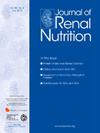Tenapanor: A Phosphate Absorption Inhibitor for the Management of Hyperphosphatemia in Patients With Kidney Failure
IF 3.2
3区 医学
Q2 NUTRITION & DIETETICS
引用次数: 0
Abstract
Because of increased risks of cardiovascular disease and death, patients with hyperphosphatemia receiving maintenance dialysis are advised to limit phosphorus consumption and are prescribed phosphate binders in an effort to better control serum phosphate concentrations. Because of large pill size, pill burden, and tolerability issues, phosphate binder adherence is relatively poor. On ingestion, phosphate is absorbed from the intestine via transcellular or paracellular transport. Data show that inhibiting sodium-hydrogen exchanger 3 modulates paracellular phosphate absorption (the predominant pathway in humans). Tenapanor is a first-in-class, minimally absorbed, phosphate absorption inhibitor that selectively inhibits sodium-hydrogen exchanger 3, with a mechanism distinct from, and complementary to, that of phosphate binders. In phase 3 and postregistrational studies, tenapanor conferred statistically significant and clinically meaningful reductions in serum phosphate in patients receiving maintenance dialysis with hyperphosphatemia. Here, we review the available preclinical and clinical data on the effects of tenapanor on controlling intestinal phosphate absorption.
Tenapanor:一种用于治疗肾衰竭患者高磷血症的磷酸盐吸收抑制剂。
由于心血管疾病和死亡的风险增加,建议接受维持性透析的高磷血症患者限制磷的摄入量,并处方磷酸盐结合剂,以更好地控制血清磷酸盐浓度。由于磷酸盐结合剂药片较大、药片负担和耐受性问题,磷酸盐结合剂的依从性相对较差。摄入磷酸盐后,磷酸盐会通过跨细胞或旁细胞转运从肠道吸收。数据显示,抑制钠-氢交换机 3 可调节细胞旁磷酸盐的吸收(人类的主要途径)。Tenapanor 是一种首创的、吸收率极低的磷酸盐吸收抑制剂,可选择性地抑制钠-氢交换器 3,其作用机制与磷酸盐结合剂不同,但又互补。在 3 期研究和注册后研究中,替那帕诺能显著降低接受维持性透析治疗的高磷血症患者的血清磷酸盐含量,并具有统计学意义和临床意义。在此,我们回顾了有关替那帕诺控制肠道磷酸盐吸收效果的现有临床前和临床数据。
本文章由计算机程序翻译,如有差异,请以英文原文为准。
求助全文
约1分钟内获得全文
求助全文
来源期刊

Journal of Renal Nutrition
医学-泌尿学与肾脏学
CiteScore
5.70
自引率
12.50%
发文量
146
审稿时长
6.7 weeks
期刊介绍:
The Journal of Renal Nutrition is devoted exclusively to renal nutrition science and renal dietetics. Its content is appropriate for nutritionists, physicians and researchers working in nephrology. Each issue contains a state-of-the-art review, original research, articles on the clinical management and education of patients, a current literature review, and nutritional analysis of food products that have clinical relevance.
 求助内容:
求助内容: 应助结果提醒方式:
应助结果提醒方式:


